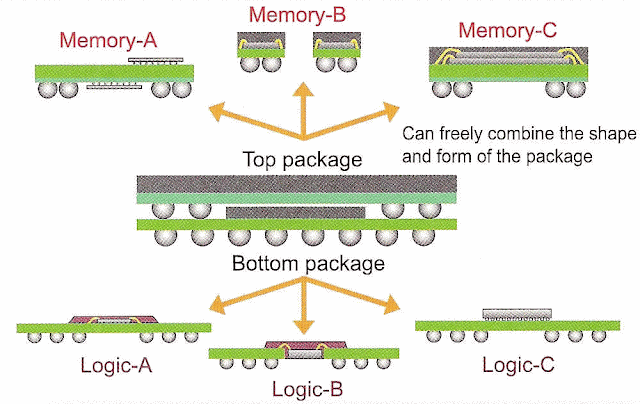3.What are PoP techniques?
3-D packages are mainly split into two types- one uses embedded techniques and the other uses layered techniques.
The embedded technique is a construction method for embedding passive parts such as resistors and conductors, and active parts such as transistors into the panel during the manufacturing process. The layered techniques is a construction method which uses layers of bare chips or layers of packages. The term Package-on-Package is used for the package layer construction method. Furthermore, there are two construction methods within PoP called "Pre-stack" and "On-board stack". To achieve Pop placement requires high level of placement technique and high performance process equipment.
3-D packages are mainly split into two types- one uses embedded techniques and the other uses layered techniques.
The embedded technique is a construction method for embedding passive parts such as resistors and conductors, and active parts such as transistors into the panel during the manufacturing process. The layered techniques is a construction method which uses layers of bare chips or layers of packages. The term Package-on-Package is used for the package layer construction method. Furthermore, there are two construction methods within PoP called "Pre-stack" and "On-board stack". To achieve Pop placement requires high level of placement technique and high performance process equipment.
3.1 Pre-Stack
The bottom package is set on a carrier jig and flux(solder paste) is applied to the top package which is then placed on top of the bottom package. They are then passed through a reflow oven to join the two layered packages together. The "Pre-stack" package is then used in the panel placement process as a single part. The part is placed on the panel and passed through a reflow oven again to bond it to the panel.
3-2.On-board Stack
Solder is printed onto the board and then the bottom package is placed onto the panel (as is the same as SMD surface mounting). Next flux(solder) is applied to the top package which is then placed on top of the bottom package. The panel is passed through a reflow oven to join the panel and bottom package, the bottom package and the top package together at the same time. On-board Stack requires only one pass through a reflow oven.
3-3.Advantages of Pre-stack and On-board Stack
Previously, it was possible to efficiently reduce the placement area by creating layers of placed packages separete on the panel surface. Both Pre-stack and On-board Stack have their own characteristic advantages which depend on the construction method. Flexible panel design is made possible due to the freedom in combining the shape and form of the package.
Pre-stack advantages
.Reliability is guaranteed for each layered package
.Can be performed at standard SMT lines
.Suitable for large scale production
On-board Stack advantages
.Can support flexible part combinations
.Specification changes are possible in a short time span
.can help to minimize work in progress inventory




No comments:
Post a Comment